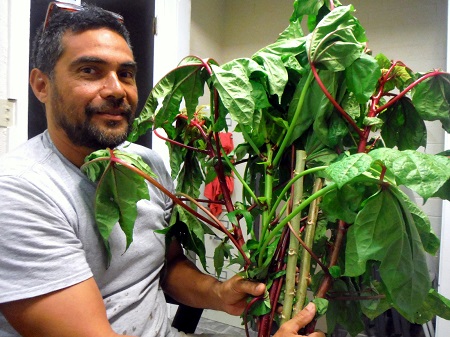

Laupele for Your Health at First Friday Courtesy ASCC/CNR
March 10, 2014
By James Kneubuhl, ASCC Press Officer
The Community and Natural Resources Division (CNR) of the American Samoa Community College would like the public to know about a healthy, nutritious leafy green vegetable that may already be growing in your own back yard. Laupele or Edible Hibiscus (Abelmoschus manihot) is one of the most nutritious of all leafy green vegetables. Rich in protein, fiber, iron, calcium, vitamin A and zinc, it is more nutritious than Chinese cabbage or even spinach, and is very easy to grow in American Samoa.
CNR has several new varieties of laupele that were produced through crossing of the traditional varieties found locally. To encourage the public to grow this potential food source, Agriculture Extension Agents from CNR gave out free cuttings of these new laupele varieties at the Fagatogo Market Place during the First Friday event for March. “If you plant cuttings close to your home, you can have a steady supply of free and nutritious vegetables,” said CNR Horticulturalist Ian Gurr.
With obesity, diabetes and heart disease having become a challenge for many in the Territory, nutritionists recommend an increased consumption of vegetables as an alternative to fatty and sugary foods in order for us to become healthier. However, easy access to common favorites among leafy green vegetables such as lettuce and spinach has long been a problem for local residents because of the unsteady supply and high cost of imported groceries. With these factors in mind, Gurr described the laupele as “the ideal vegetable to grow in American Samoa. It’s very nutritious and easy to cultivate in our climate. It can be grown from cuttings and can be harvested multiple times over a period of many months or even years.”
Over the course of months researching the laupele, not only as a plant species but also as a food, some CNR staff remarked on it occasionally having a taste they described as “slippery”, depending on how it is cooked. Gurr said this rubbery or slippery texture is easily remedied by, first, choosing tender, younger leaves rather than mature ones. Do not soak the leaves in water before cooking, but rinse them quickly in running water and set them aside to drain. Instead of tearing the leaves by hand, cut them with a sharp knife, and if boiling the laupele, wait till the water is at a boil before adding the leaves. “Laupele can also be blended into scrambled eggs or pancakes using a hand blender or regular blender to make it more appealing for young children,” said Gurr.
Anyone interested in finding out more about the laupele can talk with the CNR Extension Agents, who can be reached at 699–1575.
